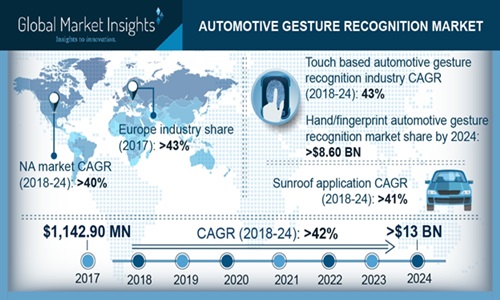Automotive Gesture Recognition Technology: The Next Level in Road Safety
Author : Pankaj Singh | Published Date : 2019-02-26

The growing sales of luxury cars having advanced safety and comfort features have fueled the development of the automotive gesture recognition market, as automakers seek to incorporate more technologies for improving overall driving experience. Gesture control not only makes using various in-built systems easier, but also reduces the probability of causing a distraction-related accident by promising a minimum need for taking one’s eyes away from the road. As automobile manufacturers, governments and consumers become increasingly aware about the benefits this technology, component suppliers have begun to design dedicated electronic hardware to support gesture recognition. A report by Global Market Insights, Inc. estimates that the automotive recognition market size will surpass US$13 billion worldwide by 2024.
Lately, more consumers have been preferring vehicles equipped with the newest infotainment systems that offer seamless connectivity with smartphones and other wireless devices. Increased penchant for travelling and the growth of mobility services have greatly propelled the inclusion of navigation systems in most of the new cars being produced today. No matter how useful these systems are, it must be noted that most of them are traditionally operated by buttons and warrant a diversion of the driver’s attention, even if for just a little more than a second.
Limitations of existing system control technologies
Consider a vehicle being driven at 40 miles/hour and the driver needs to adjust the volume of the radio, or even change the channel, which might take the driver’s eyes away for about 1.2 seconds. A car travelling at that speed will cover more than 20 meters in 1.2 seconds, opening possible corridors for a mishap just waiting to happen. Now combine this scenario with the multitude of features available in vehicles today, in addition to the alarming rise in the use of mobile phones while driving. Touch-less automotive gesture recognition technology could come into play here, using which a driver can swiftly adjust any settings with the help of certain standard hand gestures.
It is true that gradual expansion of voice recognition and control technology within cars has made operating various features simpler, but it brings along other limitations. Accents and speech recognition, background noise and restricted list of commands are some problems in voice recognition that still require enormous investment in time and money. Several key technology companies have almost overcome these challenges, but there still a long road for voice control to go beyond its rudimentary functions we see today. Also, deaf and mute people would not be able to use this technology.
Potential of touch-less gesture recognition technology for improving road safety
Distractions inside the vehicle are a mounting cause of passenger as well as light and heavy vehicle accidents that result in fatalities. According to statistics disclosed by U.S. government agencies, distracted driving amounts to nearly 25% of all motor vehicle fatalities in the country, with the count reaching 3,477 traffic deaths in 2015. A total of 391,000 injuries had been attributed to distracted driving in the same year, teen driving constituting a major proportion of the accidents.
In Britain itself, around 3,254 accidents in 2017 had occurred due to mobile use and in-vehicle distractions, as reported by the Department for Transport. Experts believe a notable percentage of such accidents can be cut down by the implementation of gesture recognition to use features like adjusting volumes and air flow, picking calls on connected phones, changing music playlist, among others. These may seem like basic, easily performed functions, but account for considerable distraction from driving. Electronic design capabilities have surged tremendously with the latest available tools and technical developments, increasing the flexibility and adaptability of in-car systems to work with other technologies.
Though still in its infancy, not even as advanced as current voice recognition technologies, investing in touch-less gesture recognition is being perceived as much better allocation of resources than other alternatives. Imagine not needing to find a button or touch-screen to answer phones, operate music or navigation, open or close windows, sunroof in salons or collapsible roof in convertibles, as well as locking the doors. Automakers have already introduced such features, like Mercedes S-Class in which the trunk can be opened using movement of one’s foot.
Moving away from passenger and other lightweight cars, safety can also be improved in heavy commercial vehicles using gesture recognition, especially since HCV drivers are prone to distractions during long hours of travelling. It was not long ago that a truck driver was reported to have crashed and killed a family because he got distracted changing songs on his phone. Although using a phone or listening to music are not ideal activities to be done inside a vehicle, it is unlikely people would be changing their habits to curb accidents.
Consequently, for avoiding similar tragedies, technologies like gesture recognition need to be incorporated in automobiles to ensure drivers do not need to divert concentration away from the road. Even physically handicapped people who are allowed to drive can utilize touch-less gesture functions through proper practice and necessary adjustments.
Overview of present advancements in gesture recognition technology
Recently, electronic component manufacturer Microchip Technologies, Inc. unveiled a new 3D gesture recognition controller which is meant to be a single-chip solution for advanced human machine interfaces in automobiles. It is claimed to have the lowest system cost in the sector and enables designers to incorporate features like light switching and answering calls, for starters. 3D gesture control can also allow drivers to operate audio systems with the wave of your hand, a technology which has already found its way into modern television sets. With various limitations in designing gesture control using cameras, sensors are being tested and developed to assist in propagating the use of the technology.
A leading player in the global automotive gesture recognition market, Continental boasts of a product which consists of standard swipe gestures as well as the ability to customize. It can be used for transferring applications from main display to instrument cluster and vice-versa, along with operating the infotainment system. Other companies in the sector, such as Intel, Delphi and Visteon are also offering gesture recognition solutions and seeking continuous innovations in the field.
As the significance of driver safety technologies gain momentum in conjunction with the augment of electric and self-driving vehicles, gesture recognition will soon become a common inclusion when designing the vehicle cockpit. Automotive segment has always brought new challenges to electronic design and implementing the vision of a touch-less control to reduce the rate of fatal accidents will critically transform the electronic hardware and software industries.
About Author
Pankaj Singh . .

Endowed with a post graduate degree in management and finance, Pankaj Singh has been a part of the online content domain for quite a while. Having worked previously as a U.K. insurance underwriter for two years, he now writes articles for fractovia.org and other online portals. He can be contacted at- [email protected] | https://twitter.com/PankajSingh2605
Related News
Bayers new CEO initiates management job cuts to accelerate decision-making
Bayer newly appointed CEO, Bill Anderson, has reportedly unveiled plans to streamline the companys management structure in a bid to expedite decision-making processes. This marks the first step in a broader effort to transform the embattled German company, which has been under pressure from inv... Read More>>
Smurfit Kappa in Merger Talks with WestRock worth $19 Billion
Smurfit Kappa, a prominent player in the packaging industry, is reportedly engaged in merger discussions with its US counterpart, WestRock. This prospective merger has the potential to create a cardboard box-making powerhouse boasting a market value approaching $19 billion (€17.8 billion). Furt... Read More>>
RBC plans job cuts to take on anticipated economic softening
The Royal Bank of Canada is reportedly planning to reduce its workforce by approximately 1,800 jobs as part of cost-cutting measures, on account of the anticipated upcoming economic landscape. This decision comes after the country's largest bank surpassed analysts' predictions for the third ... Read More>>


